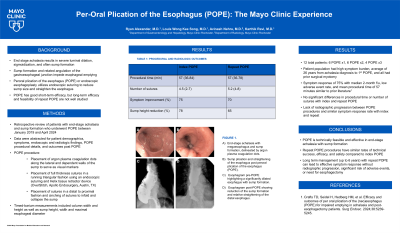Sunday Poster Session
Category: Esophagus
P0494 - Per-Oral Plication of the Esophagus (POPE) for End-Stage Achalasia: The Mayo Clinic Experience
Sunday, October 27, 2024
3:30 PM - 7:00 PM ET
Location: Exhibit Hall E

Has Audio
- RA
Ryan Alexander, MD
Mayo Clinic
Rochester, MN
Presenting Author(s)
Ryan Alexander, MD, Louis Wong Kee Song, MD, Avinash Nehra, MD, Karthik Ravi, MD
Mayo Clinic, Rochester, MN
Introduction: End-stage achalasia with sump formation is traditionally managed with esophagectomy, a procedure with significant morbidity. Peroral plication of the esophagus (POPE) is a therapeutic intervention that can reduce sump size, straighten the esophagus, and potentially improve patient symptomatology in end-stage achalasia. The study aim was to assess the efficacy and safety of POPE in end-stage achalasia with sump formation.
Methods: Patients who underwent upper endoscopy in which endoscopic suturing (OverStitch, Apollo Endosurgery, Austin, TX) was performed from January 2016 to April 2024 were identified through review of a prospectively maintained endoscopy database. Manual review of the endoscopic and electronic medical records was then conducted to identify patients who underwent POPE. Data were abstracted for patient demographics, clinical characteristics, and endoscopic and radiographic findings. All contrast esophagrams were reviewed by a single gastrointestinal radiologist.
Results: Twelve patients (50% male, mean age 66 years old) underwent a total of 22 POPE procedures. Dysphagia (83%) and regurgitation (67%) were the more common symptoms. The mean time interval between initial achalasia diagnosis and 1st POPE was 26 years, with all patients having undergone prior pneumatic dilation and 10 (83%) patients having had prior surgical myotomy. The mean procedural time for POPE was 57 minutes, with a mean of 4.5 full-thickness sutures placed in running, triangular fashion. There were no immediate procedural adverse events. Nine (75%) patients reported symptomatic improvement at a mean follow-up of 15 months (range 0.1-51 months), and 6 of 7 (86%) patients who had post-procedural esophagrams had improvement in sump size at a mean follow-up of 5 months (range 0-24 months). Six of 12 patients underwent a 2nd POPE at a mean of 2.6 years after the 1st POPE, while 4 patients had a 3rd POPE at a mean of 3.1 years after the 2nd POPE. One episode of aspiration pneumonia occurred 2 weeks after a 2nd POPE in one patient. There was no evidence of radiographic progression of esophageal diameter or sump size at the time of interval POPE.
Discussion: POPE was found to be safe and relatively effective in our case series. Although suture plication durability and symptom recurrence are of concern, POPE can be repeated. POPE appears to be a viable treatment option for end stage achalasia with sump formation, and may be considered destination therapy in select cases.
Disclosures:
Ryan Alexander, MD, Louis Wong Kee Song, MD, Avinash Nehra, MD, Karthik Ravi, MD. P0494 - Per-Oral Plication of the Esophagus (POPE) for End-Stage Achalasia: The Mayo Clinic Experience, ACG 2024 Annual Scientific Meeting Abstracts. Philadelphia, PA: American College of Gastroenterology.
Mayo Clinic, Rochester, MN
Introduction: End-stage achalasia with sump formation is traditionally managed with esophagectomy, a procedure with significant morbidity. Peroral plication of the esophagus (POPE) is a therapeutic intervention that can reduce sump size, straighten the esophagus, and potentially improve patient symptomatology in end-stage achalasia. The study aim was to assess the efficacy and safety of POPE in end-stage achalasia with sump formation.
Methods: Patients who underwent upper endoscopy in which endoscopic suturing (OverStitch, Apollo Endosurgery, Austin, TX) was performed from January 2016 to April 2024 were identified through review of a prospectively maintained endoscopy database. Manual review of the endoscopic and electronic medical records was then conducted to identify patients who underwent POPE. Data were abstracted for patient demographics, clinical characteristics, and endoscopic and radiographic findings. All contrast esophagrams were reviewed by a single gastrointestinal radiologist.
Results: Twelve patients (50% male, mean age 66 years old) underwent a total of 22 POPE procedures. Dysphagia (83%) and regurgitation (67%) were the more common symptoms. The mean time interval between initial achalasia diagnosis and 1st POPE was 26 years, with all patients having undergone prior pneumatic dilation and 10 (83%) patients having had prior surgical myotomy. The mean procedural time for POPE was 57 minutes, with a mean of 4.5 full-thickness sutures placed in running, triangular fashion. There were no immediate procedural adverse events. Nine (75%) patients reported symptomatic improvement at a mean follow-up of 15 months (range 0.1-51 months), and 6 of 7 (86%) patients who had post-procedural esophagrams had improvement in sump size at a mean follow-up of 5 months (range 0-24 months). Six of 12 patients underwent a 2nd POPE at a mean of 2.6 years after the 1st POPE, while 4 patients had a 3rd POPE at a mean of 3.1 years after the 2nd POPE. One episode of aspiration pneumonia occurred 2 weeks after a 2nd POPE in one patient. There was no evidence of radiographic progression of esophageal diameter or sump size at the time of interval POPE.
Discussion: POPE was found to be safe and relatively effective in our case series. Although suture plication durability and symptom recurrence are of concern, POPE can be repeated. POPE appears to be a viable treatment option for end stage achalasia with sump formation, and may be considered destination therapy in select cases.
Disclosures:
Ryan Alexander indicated no relevant financial relationships.
Louis Wong Kee Song: Noah Medical – Consultant. Steris – Consultant.
Avinash Nehra indicated no relevant financial relationships.
Karthik Ravi indicated no relevant financial relationships.
Ryan Alexander, MD, Louis Wong Kee Song, MD, Avinash Nehra, MD, Karthik Ravi, MD. P0494 - Per-Oral Plication of the Esophagus (POPE) for End-Stage Achalasia: The Mayo Clinic Experience, ACG 2024 Annual Scientific Meeting Abstracts. Philadelphia, PA: American College of Gastroenterology.
